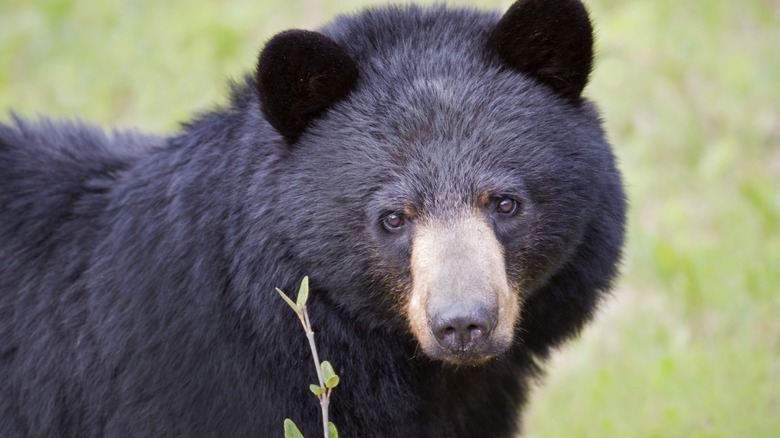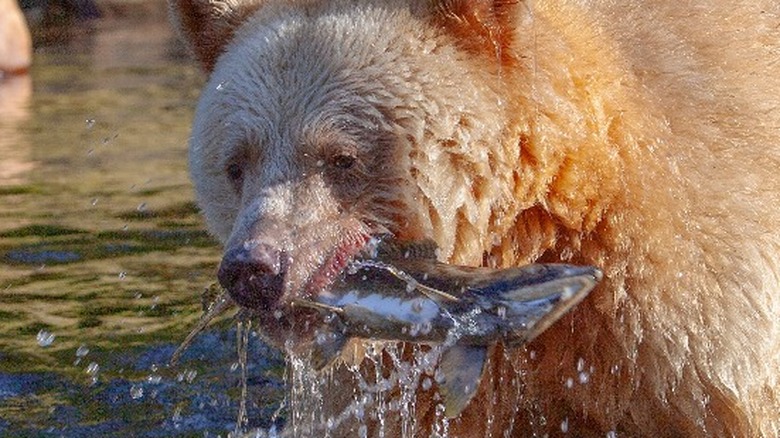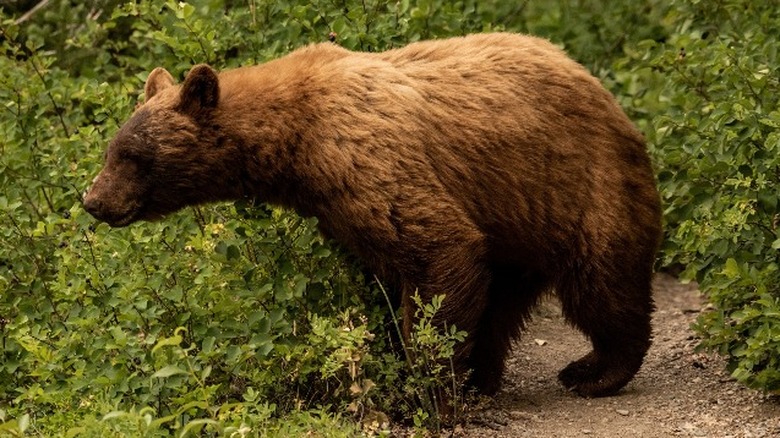The American Black Bear Might Need A New Name In The Future
Black bears are the most common bear in North America (via Field and Stream). However, if you travel throughout the black bear's range, you may notice something odd — many of them aren't black.
Many western black bears are a "cinnamon" or "copper" brown. In December, 2022, Current Biology published a study exploring what causes this color (via Live Science). The study, "Genetic architecture and evolution of color variation in American black bears" by Emily E. Puckett et al, found that it's attributable to a genetic mutation in the gene called tyrosinase-related protein 1 (TYRP1). As Puckett explained to Live Science, "TYRP1 is a known pigmentation gene in the pathway in the precursor molecules that ultimately produces either eumelanin (black or brown pigment) or pheomelanin (red or yellow pigment)." Bears with the TYRP1-R153C mutation have less eumelanin than darker bears, according to Phys.
The study was a collaboration between researchers from the University of Memphis, the University of Pennsylvania, and HudsonAlpha Institute for Biotechnology. They studied DNA and hair samples from North American bears, in cooperation with various wildlife agencies (via Phys). The mutation was most common in the southwestern U.S. The researchers therefore think the mutation most likely started in the western U.S. around 9,360 years ago, and spread from there. Most eastern bears are still black, since black bears won't cross the Great Plains and would therefore have to go north through Canada and back down to reach the other side of the U.S. (via Live Science).
Color variation in black bears
Black bears can come in many colors, not just brown and black. There are blond, white, and blue-gray black bears as well. They have more color variation than any other North American mammal, according to the North American Bear Center (NABC). However, 90% of black bears in Yosemite National Park are brownish (via Field and Stream). Settlers arriving in eastern North America called the species black bears because they saw the black ones first, according to the NABC.
In southeastern Alaska, the Glacier bear can be blue-gray. This color is becoming rarer as glaciers melt, allowing the bears to migrate farther and mate with other groups. Kermode bears, another black bear subspecies, are found on islands off British Columbia. As many as 20% of Kermode bears are whitish and are called Spirit Bears, per the NABC. Albino black bears also exist, but Spirit Bears aren't albino, according to Field and Stream.
The researchers of the study "Genetic architecture and evolution of color variation in American black bears" noted that the mutation is very similar to the one that causes oculocutaneous albinism in humans. This type of albinism features skin and hair that is reddish in hue, and poor eyesight. However, skin and eyesight aren't affected in bears with the mutation (via Phys).
Reasons for the color variation
Even before publication of the study "Genetic architecture and evolution of color variation in American black bears" by Emily E. Puckett et al, scientists had proposed several theories about why some black bears aren't black. One theory was that the eastern bears' black fur and higher melanin levels prevented them from being badly scraped in dense eastern forests, per the North American Bear Center (NABC). Another was that western black bears had evolved to resemble the more aggressive grizzly bear to protect themselves (via Phys). Another theory, according to Field and Stream, was that they were thermoregulating: lightening their fur in hotter areas so they would not absorb and retain so much heat.
However, researchers of the study think the difference is an example of crypsis. Crypsis allows prey animals or ambush predators to better blend in with their environment (via Phys). Field and Stream notes that black coats are better for camouflage in dense forests, whereas brown coats are preferable in rocky areas with less vegetation. In any case, the black bear species' color-specific name has never been particularly accurate.


